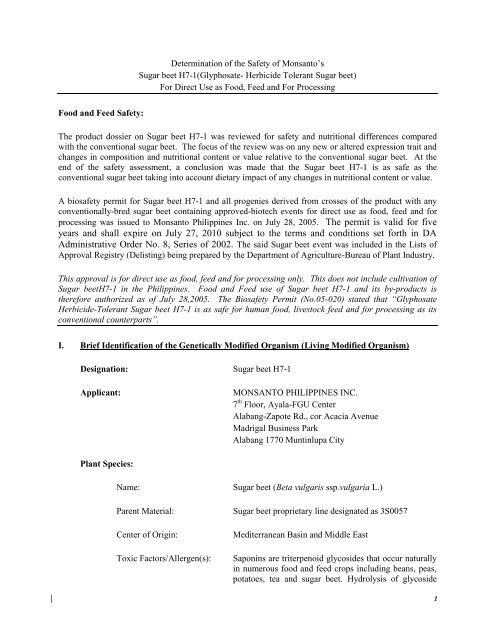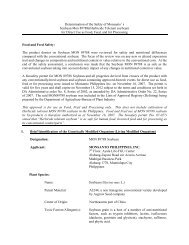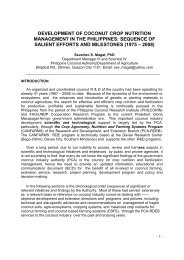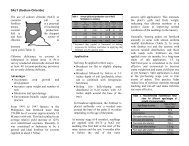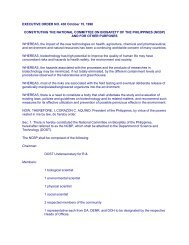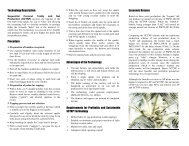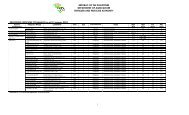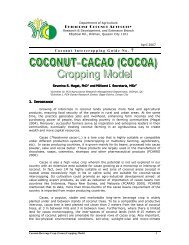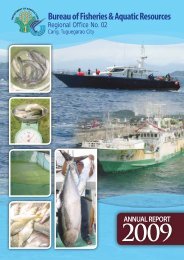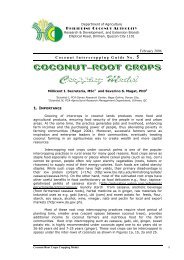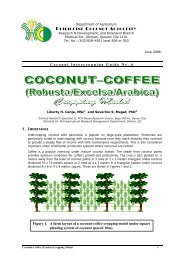Sugarbeet H7-1 - Biotechnology - Department of Agriculture
Sugarbeet H7-1 - Biotechnology - Department of Agriculture
Sugarbeet H7-1 - Biotechnology - Department of Agriculture
- No tags were found...
Create successful ePaper yourself
Turn your PDF publications into a flip-book with our unique Google optimized e-Paper software.
Determination <strong>of</strong> the Safety <strong>of</strong> Monsanto’sSugar beet <strong>H7</strong>-1(Glyphosate- Herbicide Tolerant Sugar beet)For Direct Use as Food, Feed and For ProcessingFood and Feed Safety:The product dossier on Sugar beet <strong>H7</strong>-1 was reviewed for safety and nutritional differences comparedwith the conventional sugar beet. The focus <strong>of</strong> the review was on any new or altered expression trait andchanges in composition and nutritional content or value relative to the conventional sugar beet. At theend <strong>of</strong> the safety assessment, a conclusion was made that the Sugar beet <strong>H7</strong>-1 is as safe as theconventional sugar beet taking into account dietary impact <strong>of</strong> any changes in nutritional content or value.A biosafety permit for Sugar beet <strong>H7</strong>-1 and all progenies derived from crosses <strong>of</strong> the product with anyconventionally-bred sugar beet containing approved-biotech events for direct use as food, feed and forprocessing was issued to Monsanto Philippines Inc. on July 28, 2005. The permit is valid for fiveyears and shall expire on July 27, 2010 subject to the terms and conditions set forth in DAAdministrative Order No. 8, Series <strong>of</strong> 2002. The said Sugar beet event was included in the Lists <strong>of</strong>Approval Registry (Delisting) being prepared by the <strong>Department</strong> <strong>of</strong> <strong>Agriculture</strong>-Bureau <strong>of</strong> Plant Industry.This approval is for direct use as food, feed and for processing only. This does not include cultivation <strong>of</strong>Sugar beet<strong>H7</strong>-1 in the Philippines. Food and Feed use <strong>of</strong> Sugar beet <strong>H7</strong>-1 and its by-products istherefore authorized as <strong>of</strong> July 28,2005. The Biosafety Permit (No.05-020) stated that “GlyphosateHerbicide-Tolerant Sugar beet <strong>H7</strong>-1 is as safe for human food, livestock feed and for processing as itsconventional counterparts”.I. Brief Identification <strong>of</strong> the Genetically Modified Organism (Living Modified Organism)Designation: Sugar beet <strong>H7</strong>-1Applicant:MONSANTO PHILIPPINES INC.7 th Floor, Ayala-FGU CenterAlabang-Zapote Rd., cor Acacia AvenueMadrigal Business ParkAlabang 1770 Muntinlupa CityPlant Species:Name:Parent Material:Center <strong>of</strong> Origin:Toxic Factors/Allergen(s):Sugar beet (Beta vulgaris ssp.vulgaria L.)Sugar beet proprietary line designated as 3S0057Mediterranean Basin and Middle EastSaponins are triterpenoid glycosides that occur naturallyin numerous food and feed crops including beans, peas,potatoes, tea and sugar beet. Hydrolysis <strong>of</strong> glycoside1
eleases a lipid-soluble sapogenin. The predominantsapogenin in sugar beet is oleanolic acid, whosestructure is well characterized. Generally saponins havea bitter and astringent taste and act as a deterrent t<strong>of</strong>oraging. Saponins are actively eliminated during sugarprocessing and thus do not pose a risk to human health.Analysis for saponins in sugar beet usually consists <strong>of</strong>liberation <strong>of</strong> the oleanolic acid, which is quantified byHPLC.Trait Description:Trait Introduction Method:Donor Organism:Pathogenicity:Proposed Use:Herbicide (glyphosate) toleranceAgrobacterium tumefaciens mediated transformationAgrobacterium sp. strain CP4, the source <strong>of</strong> thecp4epsps gene, which confers tolerance to the herbicideglyphosate.Agrobacterium sp. CP4 is non-pathogenic, ubiquitous innature and is ordinarily present in food derived fromplant sourcesFor direct use as food, feed and for processingII.Background InformationOn October 27, 2004 Monsanto Philippines Inc. submitted an application to the Bureau <strong>of</strong> PlantIndustry requesting for biosafety permit under AO#8 part 5 for Sugar beet <strong>H7</strong>-1 which has beengenetically modified for herbicide resistance.Monsanto Philippines, Inc. has provided data on the identity <strong>of</strong> Sugar beet <strong>H7</strong>-1 a detaileddescription <strong>of</strong> the transformation method, data and information on the gene insertion sites, copynumber and levels <strong>of</strong> expression in the plant, the role <strong>of</strong> the inserted genes and regulatory sequencesin donor organisms and full nucleotide sequences. The novel proteins were identified, characterizedand compared to the original bacterial proteins, including an evaluation <strong>of</strong> their potential toxicity tolivestock and non-target organisms. Relevant scientific publications were supplied.Sugar beet <strong>H7</strong>-1 has been evaluated according to BPI’s safety assessment by concerned agencies(Bureau <strong>of</strong> Animal Industry (BAI), Bureau <strong>of</strong> <strong>Agriculture</strong>, Fisheries and Product Standards(BAFPS) and a Scientific Technical Review Panel (STRP). The process involves an intensiveanalysis <strong>of</strong> the nature <strong>of</strong> the genetic modification together with a consideration <strong>of</strong> general safetyissues, toxicological issues and nutritional issues associated with the modified sugar beet.The petitioner/applicant published the said application on two widely circulated newspapers(Malaya and Manila Times) on June 1, 2005 for public comment/review. BPI received no commenton the petition during the 30-day comment period.2
III.Description <strong>of</strong> Novel (Introduced) TraitsGlyphosate, the active ingredient in Roundup® agricultural herbicides, kills plants by inhibiting theenzyme 5-enolpyruvylshikimate-3-phosphate synthase (EPSPS). This enzyme is a critical step inthe shikimic acid pathway for the biosynthesis <strong>of</strong> aromatic amino acids in plants andmicroorganisms, and its inhibition leads to the lack <strong>of</strong> growth in plants. The aromatic amino acidbiosynthetic pathway is not present in mammalian, avian or aquatic animals. This explains theselective activity in plants and contributes to the low risk to human health and the environmentfrom the use <strong>of</strong> glyphosate according to label directions.Using modern biotechnology, Monsanto Company has developed Roundup Ready® sugar beetplants (Beta vulgaris ssp vulgaris) that are tolerant to glyphosate. The genetically modified sugarbeet plant was produced by the introduction <strong>of</strong>: the cp4 epsps gene derived from the common soilbacterium Agrobacterium strain CP4 which encodes for the production <strong>of</strong> the CP4 EPSPS enzymeand the gox gene from Ochrobactrum anthropi strain LBAA which encodes for the production <strong>of</strong>the enzyme glyphosate oxidase (GOX). Both gene products are responsible for conferring toleranceto glyphosate.Safety <strong>of</strong> Expressed ProteinsThe CP4 EPSPS protein is from Agrobacterium sp. CP4 strain, a common soil bacterium, and theGOX v247 coding sequence is from Ochrobactrum anthropi train LBAA, also a common soilbacterium. Both bacteria do not encode for any known pathogenic or allergenic proteins.The CP2EPSPS proteins are functionally similar to a diverse family <strong>of</strong> EPSPS proteins typicallypresent in food and feeds derived from plant microbial sources. EPSPS proteins are foundubiquitously in all plant-derived foods. The amino acid sequence <strong>of</strong> CP4EPSPS and other EPSPSproteins found in food are comparable. The CP4 EPSPS protein has no known similarity withknown protein toxins; CP4 EPSPS are not stable to heat or processing. The Cp4 EPSPS is rapidlydegraded by proteolytic enzymes (digestibility in vitro), limiting the exposure <strong>of</strong> the GIT and lesslikelihood that the protein can exert pharmacological, toxic or allergic effects.GOX is an enzyme involved in the oxidation <strong>of</strong> a synthetic compound known as glyphosate and isnot directly involved in the basic metabolism <strong>of</strong> mammalian systems.Both proteins are non-toxic and non-allergenic based on comparative analysis <strong>of</strong> their amino acidsequences to known protein toxins and allergens using specific bioinformatics tools.Glyoxylate is a compound naturally present in plant cells involved in carbohydrate and amino acidmetabolism. It is <strong>of</strong> no safety concern.AMPA is <strong>of</strong> no toxicological concern. It can be non-selective bound to natural plant constituents,further degraded to one carbon fragment that are incorporated into natural products, or conjugatedwith naturally occurring organic acids. Both substances are not prevalent in sugar beet event <strong>H7</strong>-1.They are not stable to digestion and processing, and have no similarity to known allergen.3
IV.Nutritional Composition (Compositional Analysis)Under the same agronomic condition as conventional counterpart sugar beet did not significantly(statistically and biologically) differ in terms <strong>of</strong> quantity and quality <strong>of</strong> the key nutrients, the aminoacids-Alanin, Arginine, Aspartic, Cystine, Glutamic, Glycine, Histidine, Isoleucine, Leucine, andLysine. CP4EPSPS and GOXv247 proteins have no effects on the key nutrients. Values were wellwithin the range.The acute oral toxicity studies (gavage assay) on mice using highest dose administered (572 mg/kgbody weight) gave no adverse effects and this represented a “NOEL” or NO-EFFECT-LEVEL.V. Anti-Nutritional FactorsThe levels <strong>of</strong> anti-nutrients (saponins) are only data provided. Saponin is actively eliminated duringprocessing and level content is comparable to conventional sugar beet.VI.Regulatory DecisionAfter reviewing the scientific data and information relevant to the application <strong>of</strong> MonsantoPhilippines Inc., it is concluded that Sugar beet event <strong>H7</strong>-1 and all progenies derived from crosses<strong>of</strong> the product with any conventionally-bred sugar beet, and sugar beet containing approved-biotechevents for direct use as food, feed and for processing is as safe and substantially equivalent to itsunmodified counterpart, and is therefore approved for direct use as food, feed and for processing.Monsanto hall duly inform the public <strong>of</strong> this approval by way <strong>of</strong> publishing in any one (1) <strong>of</strong> thetop three (3) leading newspapers in the country that imports <strong>of</strong> this product is covered by conditionsfor approval as provided in <strong>Department</strong> <strong>of</strong> <strong>Agriculture</strong> Memorandum Circular No. 8, Series <strong>of</strong>2003.4


